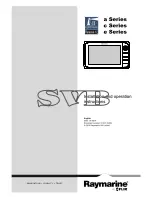
IonPacAS9-SC
034656-06
Page 17 of 28
5.2
Inorganic Anions Including Chlorate and Chlorite
Separation and elution of anions on the IonPac AS9-SC Analytical Column has been optimized utilizing a carbonate/bicarbonate
eluent. By using this eluent, monovalent and divalent anions can be isocratically separated and quantitated in a single injection.
The carbonate/bicarbonate mixture allows the strength of the eluent, and thus the selectivity of the system to be changed by varying
the HCO
3
-
/CO
3
2-
ratio. Furthermore, the suppressor reaction product is carbonic acid (H
2
CO
3
) and results in a low background
conductivity (14-18 µS) suitable for isocratic analysis. For samples with similar concentrations of ions, the run time can be
decreased to 1/2 the standard run time by doubling the flow rate. For samples with highly variable concentrations, additional
resolution can be obtained at lower flow rates (see Section 4.4, Resolution of Low-Concentration Analytes).
Sample Loop Volume:
25 µL
Analytical Column:
IonPac AS9-SC Analytical Column
Eluent:
1.8 mM Na
2
CO
3
/1.7 mM NaHCO
3
Eluent Flow Rate:
See Chromatogram
SRS Suppressor:
Anion Self-Regenerating Suppressor, ASRS-ULTRA
AutoSuppression Recycle Mode
or AES Suppressor:
Anion Atlas Electrolytic Suppressor, AAES
or MMS Suppressor:
Anion MicroMembrane Suppressor, AMMS III
MMS Regenerant:
25-50 mN H
2
SO
4
Expected Background Conductivity:
12-16 µS
Long-term Storage Solution (> 1 week):
100 mM Sodium Bicarbonate
Short-term Storage Solution (< 1 week):
Eluent
Figure 2
Inorganic Anions including Chlorate, Chlorite and Bromate
Flow Rate = 2.0 mL/min
1
2
3
4
5
6
7
8
9
10
0
5
10
Minutes
-5
15
μ
S
10
5
0
Flow Rate = 1.0 mL/min
1
2
3
4
5
6
7
8
9
10
0
5
10
15
20
-5
15
μ
S
Minutes
10
5
0
Analyte
mg/L
1.
Fluoride
1.0
2.
Chlorite
5.0
3.
Bromate
1.0
4.
Chloride
1.5
5.
Nitrite
5.0
6.
Bromide
15.0
7.
Chlorate
15.0
8.
Nitrate
15.0
9.
Phosphate
20.0
10. Sulfate
25.0
















































